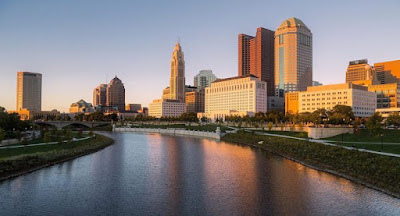Ohio: An Industrial State from the Midwest
American state located in the Great Lakes region. It has an area of 44,825 square miles, being the 34th largest state by area. Ohio contains a population of 11,689,442 inhabitants what makes it the 7th most populous state. The capital of the state is Columbus, which lies on the center of the state. It is recognized nationwide by its industries, specially the motor industry as it is the second largest producer of automobiles behind Michigan.
The third part of the eastern sector belongs to the Appalachian Plateau. The old eroded surface has been occupied by numerous valleys and tributaries of the great river Mississippi or of the Lake Erie; Ohio has a very rugged topography.
 |
| Columbus, Capital of Ohio and the Scioto River |
The southwestern section of the state contains, to south, the Old Drift Flats, plains of old glacial deposits, with abundant calcareous elements. In the center, the wide valleys of glacial circulation from the Miami and Scioto rivers, and in the north, the moraines that have buried the preglacial valleys oriented towards the west.
The vast plain of the glacial Lake Maumee occupies the northeastern part and is gradually reduced, giving place to a narrow coastline plain in the eastern zone (from Lorain to Conneaut). With highly diverse temperature variations, moved by the latitude and altitude, Ohio has a continental climate, with mild winters (on January, the thermometer can drop down to 30 degrees in Columbus) and warm summers (average temperature on July in Columbus is about 75 degrees, with a maximum temperature of 87 degrees). The precipitations are regular in all seasons (average of 37 inches in Columbus), specially in May, June and July. In the glacial deposits, this climate has favored the development, in the hardwood forests, of grey-brown podzolic soils, very adequate for the agriculture, whereas in the Appalachian Plateau, the poor podzolic soils predominate.
Colonized in the late 18th century and declared state in 1803, Ohio was, with Indiana, the first Corn Belt. Nowadays, it only occupies the easterly sector of this area. The corn production is very important in Ohio. In fact, it is the 6th largest corn producer in the United States, and 3rd one in terms of performance. The steelmaking industry is also very important. The state ranks the 2nd in the number of steel constructions. Metallurgy is also quite important. These industries stimulate the growth of different sectors, such as the transport industry: Ohio is the 3rd largest producer in the country of transport materials and the 2nd one in the list of automobile producers. The 4th in electrical constructions and electricity production, and the 5th state in what regards to the chemical industry. The mining industry is decreasing its activity, but continues to be very important for the state: it is the largest mining producer behind California and New York, obtaining every year more than 800 million dollars from this industry sector.
The hard coal deposits are located in the Appalachian Plateau and represent a prolongation of the neighboring carboniferous states. The lime is extracted under the glacial deposits, and the salt, near the Lake Erie. Ohio also produces relatively small amounts of oil and gas.
The vast majority of factories are grouped in the big urban centers: Cleveland (1,780,673 inhabitants) makes up with Akron, the Greater Cleveland conurbation (2,871,084 inhabitants) where the factories of all types and categories can be found. The Greater Cleveland is, indeed, the 6th largest industrial center of the United States, producing goods with an aggregate value of 6 billion dollars. The metropolitan area of Cincinnati, extending towards the states of Kentucky and Indiana, contains 2,137,406 inhabitants. Cincinnati is also a very important industrial center with a wide range of industries, most of them mentioned before: mechanical constructions, transport materials, chemical products, food supplies... Cincinnati is also a large commercial center (the headquarters of Kroger, United States' second largest supermarket chain by revenue, are located in this city). Despite having been in the 19th century, the largest city and main commercial center in the west from the Appalachians, it had several difficulties in competing with the "central cities network" (Indianapolis, Columbus, Dayton, Louisville) that were growing much faster.
Whereas in Columbus, the tertiary and secondary sectors go hand-in-hand, Youngstown-Warren (565,000 inhabitants) and Canton (404,432) are cities dedicated almost exclusively to the transforming sectors (factories). In fact, almost half of the workforce in these cities, work in the steelmaking industry.
Dayton (799,232 inhabitants) produces specially aviation equipments, tools, household appliances and computers. The mechanical constructions also represent the main industry in Toledo (608,145 inhabitants).
6 of the 10 most important North American ports in the Great Lakes region, mark out Ohio's facade on Lake Erie: Toledo and Sandusky export the coal and the coke from the Appalachian basin; Cleveland, Lorain and Ashtabula receive the iron mineral used in Ohio's industry and also in the industries from neighboring states; Conneaut is annexed to the Port of Cleveland, many times closed to the traffic.